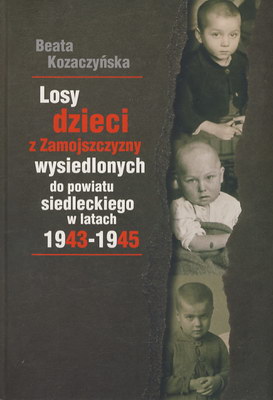Polokaust Zamosc Operation Detail Kozaczynska

Losy Dzieci Zamojszczyzny Wysiedlonych, by Beata Kozaczynska. 2006
The Polokaust in the Zamosc Region of German-Occupied Poland. Many Poles Just as Dead as the Jews Who Went to the Gas Chambers. Mass Sterilization of Slavs Planned
My review is based on the original Polish-language edition, whose title I had earlier translated as follows: THE FATE OF THE ZAMOSC-AREA CHILDREN EXPELLED AND RELOCATED AT SIEDLCE COUNTY IN 1943-1945. This poignant work centers on the human issues related to the Nazi Germans’ “Operation Zamosc.”
THE PLANNED EXTERMINATION OF POLES IN THE EVENTUAL FULLY-REALIZED POLOKAUST
The mass expulsions and partial genocide of Poles from the Zamosc area, and their replacement with German colonists, was part of the much larger GENERALPLAN OST. The latter envisioned the eastward relocation and partial genocide (including mass sterilization: p. 17) of tens of millions of Slavs.
DO NOT COMPARE ZAMOSC POLISH VICTIMS WITH THE POST-WWII GERMAN EXPELLEES (VERTRIEBENE)
The German expellees have gotten a lot of attention because of the likes of Erika Steinbach, her Center Against Expulsions, and the proposed museum of the German expellees. The author, Kozaczynska, believes that this attention has been misapplied. (p. 8). For one thing, most of the departing Germans did so voluntarily out of fear of the Red Army, or according to German orders, and not because of the direct actions of non-Germans.
The privations faced the Polish expellees, especially from the Zamosc area, far exceeded those of the post-WWII German expellees from territories awarded to Poland! As the Germans entered the Polish villages, they often killed Poles outright–especially the children, the sick and the elderly. Polish peasants, especially during the winter of 1942/1943, were forced out of their homes in the bitter cold, and many of them died while being forced to stand around awaiting further orders. Mothers and children were forcibly separated. There were many instances of Germans fatally beating mothers and/or children who resisted these separations, turning police dogs on either or both, etc. The expelled Poles were initially housed in relocation camps, where many of them, especially children, died from overcrowding, disease, and starvation. (e. g., pp. 33-34).
THE GERMAN RACIAL HIERARCHY IN ACTION
Those Zamosc-area Poles in the hands of the Germans were evaluated for “racial worth”, and divided into 4 groups. (p. 20). Those of total or partial German descent (the first two groups) were subject to further screening for possible re-Germanization. A total of 4,454 Polish children of inferred German descent were kidnapped and sent to Germany for re-Germanization. (p. 6). The third group, the “better Poles”, consisting of adult able-bodied Poles (ages 14-60) deemed capable of labor, were deported to the Reich as slaves. The fourth group, consisting of children, elderly, invalids, etc., was dispatched to special villages.
ZAMOSC POLES GENERALLY NOT GASSED. THEY HAD THE “PRIVILEGE” OF DYING IN OTHER WAYS, AND TO BE JUST AS DEAD AS THE JEWS
Holocaust-uniqueness proponents have made much of the fact that, unlike most of the Jews, the Poles removed from the Zamosc area were not sent to the gas chambers. While it is true that the Germans apparently did not use poison gas on Poles, at least on a large scale (probably out of fear of provoking intolerable guerrilla resistance, which they could less and less afford owing to increasing military reverses), they made the relocations so brutal that a significant fraction of the Poles died during the process. While those Zamosc-area Polish children sent to Auschwitz were apparently not dispatched to the gas chambers, at least not on a large scale, they were killed by another method–cardiac injections (p. 6)(with false certificates of cause of death). Finally, the proximity of the villages that received the Polish expellees to extermination camps (Treblinka, Maidanek (Majdanek), and Belzec) strongly suggests that the Germans did indeed eventually plan to gas the Poles on a large scale. (p. 21).
OTHER FACTS
The Germans were not the only ones involved in the expulsions of the Zamosc area Poles, beginning in late 1942. So were Ukrainian collaborators. (pp. 24-25, 61).
Poles and Polish organizations worked tirelessly to assist the accessible Zamosc-area expellees, whose privations were frightful. For instance, many Polish children had no shoes. (p. 134).
This book concludes with a name-by-name listing of all the thousands of Poles located in just a few of the transports of expellees from the Zamosc area. It also has a German-language summary of this entire work.
To see a series of truncated reviews in a Category click on that Category:
- All reviews
- Anti-Christian Tendencies
- Anti-Polish Trends
- Censorship on Poles and Jews
- Communization of Poland
- Cultural Marxism
- German Guilt Dilution
- Holocaust Industry
- Interwar Polish-Jewish Relations
- Jewish Collaboration
- Jewish Economic Dominance
- Jews Antagonize Poland
- Jews Not Faultless
- Jews' Holocaust Dominates
- Jews' Holocaust Non-Special
- Nazi Crimes and Communist Crimes Were Equal
- Opinion-Forming Anti-Polonism
- Pogrom Mongering
- Poland in World War II
- Polish Jew-Rescue Ingratitude
- Polish Nationalism
- Polish Non-Complicity
- Polish-Ukrainian Relations
- Polokaust
- Premodern Poland
- Recent Polish-Jewish Relations
- The Decadent West
- The Jew as Other
- Understanding Nazi Germany
- Why Jews a "Problem"
- Zydokomuna